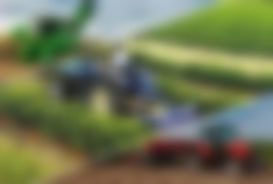As a student of Agricultural and Biosystems Engineering course, we are more focused on the agricultural sectors especially with the uses of machines in farms. One application is the mechanization of farm equipment and machines. Like other applications, mechanization has also its advantages and disadvantages. Today, I will be focusing on the disadvantages or problems we face in farm mechanization.
Mechanized agriculture or farm mechanization is the process of using agricultural machinery to mechanize the work of agriculture, greatly increasing farm worker productivity. The effective mechanization contributes to increase production in two major ways: firstly the timeliness of operation and secondly the good quality of work. The requirement of power for certain operations like seedbed preparation, cultivation and harvesting becomes so great that the existing human and animal power in the country appears to be inadequate. As a result, the operations are either partially done or sometimes completely neglected, resulting in low yield due to poor growth or untimely harvesting or both.

In G. D. Aggarwal’s words, “Farm mechanization is a term used in a very broad’ sense. It not only includes the use of machines, whether mobile or immobile, small or large, run by power and used for tillage operations, harvesting and thrashing but also includes power lifts for irrigation, trucks for haulage of farm produce, processing machines, dairy appliances for cream separating, butter making, oil pressing, cotton ginning, rice hulling, and even various electrical home appliances like radios, irons, washing machines, vacuum cleaners and hot plates.”
Here are some of the problems and possible solutions in Farm Mechanization
Financing as the imported machines are expensive

Planters are complaining that interest rates for financing machine acquisition are high (LBP interest rates are higher than private banks). Mendoza et al. (2004) argued if the interest rates go beyond 6%, the added yield or income is not enjoyed by the farmer as the added income goes mostly for debt servicing. It means the banks enjoy more the return from the efforts and investments made by the planters. (Suggested interest rates – 3 to 5%). Prices of machines are high which made the principal + interest on loans high. Prices of machine are high because they are imported. Immediate Solution: tax-free imported machine. This could be done through Cooperative (Castillo,2015). Block farms, ultimately, should be organized into coops. Planters/farmers are doubly jeopardized due to our inability to manufacture our machines/ high prices, high principal + interest on loan) and imposing tax add to greater burden for the planters. Result: many machines are of museum type (>40 years old) are still being used. This leads to the following : frequent & costly repair which delay field operations; Less-efficient; increasing the energy/money cost of operation; Delayed operations affect the productivity (quantity + quality) of canes produced; Old machines could not be used for deep tillage (vertical tillage/ chiseling) which delayed operations and also affect quality + quality of operations. Moreover, speed of work is slow.
Immediate Solution: upgrading of machines
Machine are assembly of parts consisting of engine (main part and many more >20,000 parts), tires, plus the attachment or implements. We may not be able to manufacture locally the engine within the next 10-20 years. But the tires and attachments/ implements/ plow, chisels, platform base, etc. can be manufactured locally. There is no “rocket science” involved. They can be manufactured locally. Importing them penalizes the users as the price increased excessively.
Example: 1,000 kg disc harrow set is priced at P350,000 - The raw metal part at P50/kg is only worth P50,000. The metal value increased 7 times.
Machine types suitability in relation to farm size and farm operation
Also, many imported machineries and their implements are not directly suited in our local farming conditions. Most farms are small, in turn, they need small machines. Farms are on slopes. Big machines are not suited and tires must be adjusted.
Farm implements/ attachments must be re-adjusted to suit farm operation as follows:

For Primary Tillage/ plowing, disc plows/ mold board plows are no longer suitable to soil condition. Plow clods must not be inverted. Chiseling the soil (crisscross) to avoid losing soil moisture, disruption of organic matter, soil carbon on the root zone is now the adapted primary tillage technique. Developing hard pan must be broken with extended ratoon to improve water infiltration, aeration.

Trash farming is necessary to re-build soil, increase soil organic carbon, improve water retention and other benefits (Mendoza et al. 2004). This requires trash shredder tractor attachment (but blades get dull easily). In turn, this needs disc harrow blades that can cut the trash.

Interrow cultivation for Plant crop and ratoon. Mechanical planters, fertilizer, composts and other liquid concoctions applicator all in 1 pass. But adjustable to suit planting/ furrow distance. In the Ratoon canes, trash shredders must also be designed. Ridge busting/ cut-away blades (adjustable to suit planting/ furrow distance 1.5 m single row, double rows, triple rows) should be locally prepared to suit the soil conditions and farm operations. There are many details to be considered in the design and manufacture of specific farm implements.
Machine brand/size (Hp) in relation to farm size, affordability, choice/ preference
There are many brand/ manufacturer of machines (Japan, Europe, USA, and recently South Korea and China). China made products 5 years ago are believed to be of low quality. But recent developments show that they are catching up quality-wise or improving quickly. They are cheaper (1/3 to ½ the price) of known time-tested brands (P1.5 Million vs P3.5 Million)
Time value of money or interest expense and other equally important factor for the farmer dictates that cheaper brand will be the planter’s choice.
- Recommended by the government for financing are the expensive but time-tested brand. Action: need to liberalize the government policy.
Mills to adjust milling trashy/mechanically harvested canes
Mechanically harvested canes could have up to 20% trash. If this will translate to 20% yield deduction on the part of the planters, then, no planter will be motivated to harvest their canes mechanically. But what are the effects on the part of the mills when they mill trashy canes. Can they remedy the trashy-canes problems during the milling process? Adjustments may mean added costs on their part.
Moreover, in the field, fully mechanized harvesting (using big combine machine) need to adjust or consider the following :1. Smaller farm/lot sizes; 2. Rugged to sloping terrain, 3. Soils becoming slippery when wet or becoming in accessible to the combine and hauling trucks when the soil becomes soft (clayey soils) when it rains heavily (it’s climate change!).
Labor displacement/ livelihood for displaced workers
Labor displacement is one major concerns raised against mechanization. Will this be an issue now when pressures to mechanize is due to the declining availability of harvesters or farm workers? In any country where mechanization had been introduced, this issue was raised. But how did they counteract or address it.
Initially, there was livelihood or the work activities designed for the displaced farm workers. There should be actual survey listing workers who would be displaced.
Mechanical planting
Cultivation (in furrow)
Weeding
Mechanized harvesting only very few, large, farmer is suitable for fully
Mechanized harvesting or combine harvesting.
Only cane loading is currently being entertained. Grab loader is very expensive (P3.5 M/unit). By the time locally assembled and affordable grab loader are available, the difficulties of harvesting and loading could have intensified.
Mechanize cane loading will open more work for female women in cutting canes.
Trash farming to be effectively done requires detrashing. This shall replace the other displaced work.
Integrating carabao and cattle will open livelihood (dairy-based for women).
Diversifying
Planting fruit trees, less suitable to sugarcane, will provide more income and livelihood due to processing.
Food processing that make use of sugar shall open more jobs/ livelihood for men/ women.
Local manufacture of parts for the equipment, tools, machineries, shall generate/ require labor across different stages.
REFERENCE
Mendoza, T. C. (2016). Farm mechanization is the solution. what are the problems? International Journal of Agricultural Technology 12(5):947-954.




